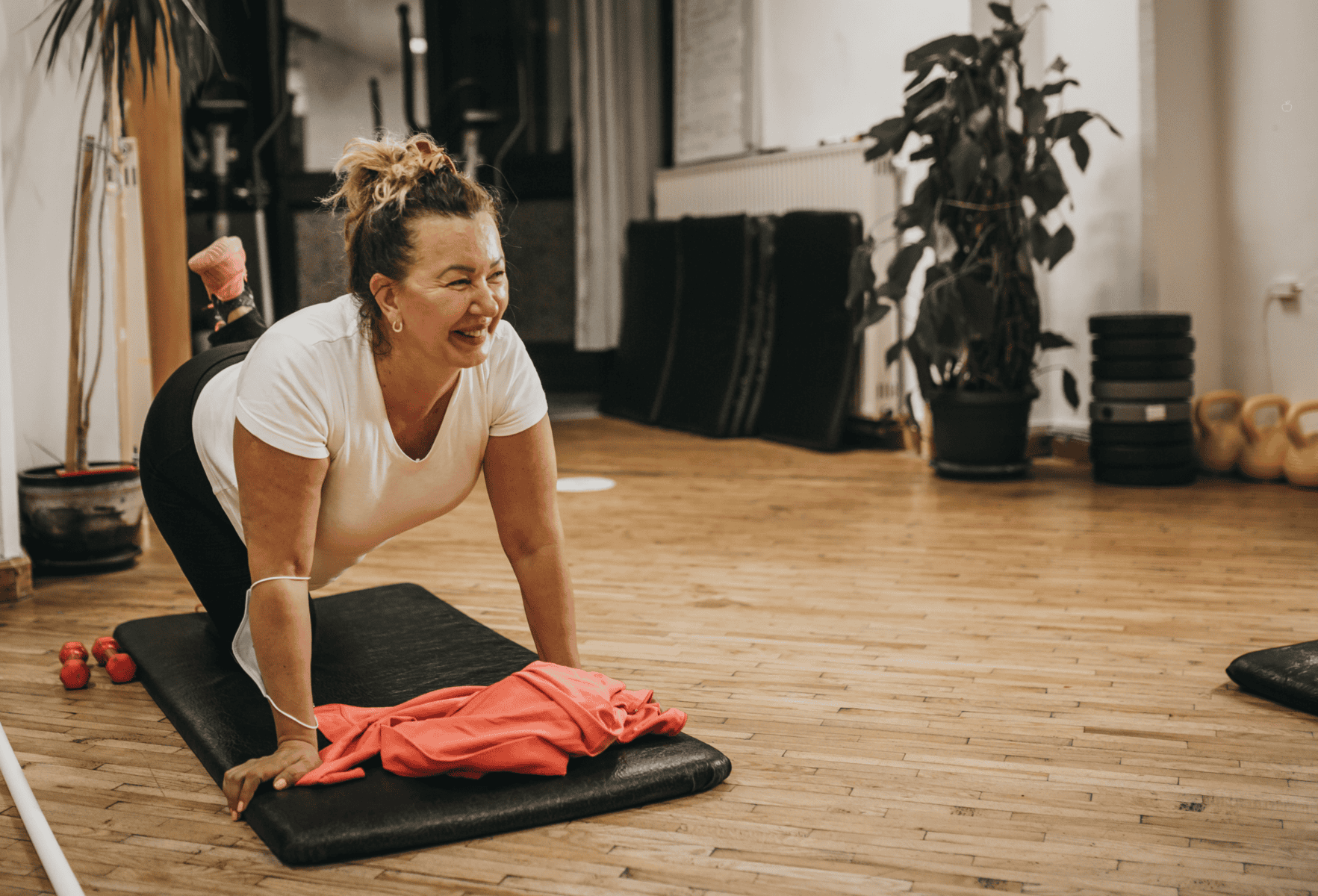
Menopause marks a major transition in a woman’s life — physically, hormonally, and emotionally. While much of the focus tends to be on hot flashes and mood swings, one area that often gets overlooked is the impact of menopause on muscle health. As oestrogen levels decline, changes in the body’s composition can lead to a noticeable decrease in muscle mass and strength. This shift has major implications for metabolism, bone health, and even daily independence.
Understanding what’s happening and how to take action can empower women to take control of their health, stay strong, and feel confident through midlife and beyond. Let’s break down what menopause does to our muscles, why it matters, and what practical steps you can take to maintain strength and vitality.
What happens to our muscles during menopause?
Muscle mass naturally declines with age, but this process can be accelerated during and after menopause.
Current research indicates that oestrogen has a role in maintaining muscle mass, evidenced by the positive correlation between hormone replacement therapy and muscle maintenance in menopausal women (1-4). Additionally, it has been observed that when oestrogen is deficient, muscle atrophy occurs and strength declines (1). However, the exact mechanism by which oestrogen maintains muscle mass remains unclear. Emerging evidence suggests that oestrogen deficiency induces apoptosis in skeletal muscle, contributing to loss of mass and strength (5). Additionally, a recent study suggests that oestrogen responsive micro-RNAs may share a mechanistic role in muscle wasting during menopause (6). So, although the exact mechanism is unknown, we do know that oestrogen deficiency does lead to reduced muscle mass in menopausal women and a condition known as Sarcopenia – age-related muscle loss.
What implications does Sarcopenia have?
Muscle loss isn’t just a cosmetic issue — it signals deeper changes that can affect how your body functions over time. In particular, we observe:
- Lower basal metabolic rate (BMR): Muscle is metabolically active, meaning it burns energy even at rest. Hence, the amount of muscle you have directly influences your BMR. As muscle mass drops, your BMR declines — making it easier to gain weight even if your diet hasn’t changed.
- Lower bone density: Resistance on bones (through movement and strength) helps stimulate bone growth and maintenance. Less muscle means less mechanical load, resulting in lower bone density. This increases the risk of osteopenia and osteoporosis.
- Increased risk of falls and fractures: With reduced muscle mass, the risk of falls is heightened, and the body is less capable of performing daily tasks. The falls are more likely to result in fractures due to the lower density of the bones.
- Metabolic changes: Lower muscle mass can impact insulin sensitivity because muscles take in a large bulk of insulin. This can also put menopausal women at risk of developing type 2 diabetes.
Practical tips: How to maintain muscle during menopause
Maintaining muscle can be achieved via adequate nutrition, strength-based exercise, and hormone replacement therapy.
1. Nutrition
Weight gain during menopause is expected due to the drastic shift in hormones. Many women respond to this by restricting their diet and drastically increasing their energy expenditure. However, this is not necessarily conducive to a healthy body in the long term.
A restrictive diet can lead to inadequate protein and other vital nutrients (7).
Additionally, when the body has insufficient protein and fuel, it will break down muscle via a process called gluconeogenesis to create energy for the body to perform its daily functions, exacerbating muscle loss.
So, what do we recommend to help maintain muscle mass? An overall balanced diet that is rich in protein.
How much protein should you eat?
The Australian Dietary Guidelines recommend that women aged between 19 and 70 consume 0.75g of protein per kilogram of body weight per day. So, if you are a 70kg woman, that equates to 52.5g of protein per day.
For building and maintaining muscle mass, current research suggests a protein intake in the range of 1.4-2.0g per kilogram of body weight per day is sufficient for most exercising individuals (8). If you are a 70kg woman, that equates to 98-140g of protein per day.
So, consuming at least 0.75g/kg/day and up to 2.0g/kg/day of protein should be sufficient to maintain muscle mass in menopausal women.
Here’s an example of a day of food that provides approximately 100 grams of protein—ideal for a 70 kg female aiming for around 1.5 g/kg/day:
| Breakfast: 2 eggs with 2 slices of wholemeal toast ~20g protein |
|---|
| Morning Snack: A tub of high-protein yoghurt or ¾ cup of Greek yoghurt with berries ~15g protein |
| Lunch: Asian crunchy noodle salad with 95g of tuna and a sprinkle of seeds ~22g protein |
| Afternoon Snack: 3 tablespoons of hummus with Vita-Weat crackers and vegetable sticks ~5g protein |
| Dinner: Chicken breast (110g raw / 85g cooked) served with vegetable curry and basmati rice ~30g protein |
| Supper: Apple with 2 tablespoons of peanut butter ~8g protein |
Additionally, you are encouraged to eat a healthy, balanced diet that includes vegetables, fruit, whole grains and protein foods to meet your nutrition needs and keep your energy levels up. Use these tips to build balanced, healthy meals:
- Load up your plate with a variety of vegetables. Vegetables should form the base of most meals. Try roasting pumpkin and parsnip alongside potatoes, or make a quick salsa by dicing tomato, red onion, and cucumber with a pinch of salt.
- Include a source of wholegrains such as oats, quinoa, brown rice, whole grain bread or pasta. Swap white bread for wholemeal, mix quinoa into your salad, or top yoghurt with a spoonful of rolled oats for added fibre and energy.
- Add a lean source of protein like legumes, fish, tofu, eggs, lean meats, dairy or fortified soy products. Trim excess fat and skin from meats and cook with olive oil. Oven-baked meats are a simple option—just cook them alongside your roasted vegetables for an easy dinner. For a plant-based option, marinate tofu for added flavour, or blend cannellini beans into pumpkin soup for a protein boost.
- Include a source of healthy fats such as nuts, seeds, avocados, plant oils, or oily fish. Drizzle olive oil over salads or roast vegetables, add avocado to your toast and eggs, or sprinkle seeds over your muesli or yoghurt.
- Enjoy two serves of fruit per day. You can include this fruit in your main meals or have it as a snack! Blend a banana into your morning smoothie or create a balanced snack plate with apple slices, wholegrain crackers, and veggie sticks.
2. Exercise
Incorporating progressive resistance training and moderate-impact weight-bearing exercises into your week is one of the best things you can do. This can include:
- Weightlifting
- Resistance bands
- Bodyweight exercises like squats, push-ups, or lunges
Current World Health Organisation Guidelines recommend that adults complete 150 minutes of moderate intensity exercise each week in addition to 2-3 resistance training/strength sessions. This equates to approximately 30 minutes of exercise per day.
Start where you are and build gradually. Even light weights can make a big difference over time.
3. Hormone Replacement Therapy
Hormone replacement therapy (HRT) works by replacing the declining oestrogen levels during menopause. While the exact mechanisms are still being explored, HRT appears to counteract some of the adverse muscular effects of oestrogen deficiency in menopausal women, preserving muscle mass. Speak to your doctor about whether HRT is suitable for you.
It can be difficult to navigate the mass of menopause information available online. So, let’s get right back to the basics.
By eating a well-balanced diet, prioritising protein, incorporating regular resistance training, and using HRT when appropriate, you can give yourself the best chance to reduce muscle wastage associated with menopause.
Additionally, muscle mass contributes significantly to body composition, and focusing on building or maintaining muscle is a more sustainable way to change your physique, compared to restrictive diets.
If you want to learn more about how best to support your body during menopause, come in and speak to an Accredited Practising Dietitian at the Healthy Eating Clinic – we are here to help!
References
- Collins, B. C., Laakkonen, E. K., & Lowe, D. A. (2019). Aging of the musculoskeletal system: How the loss of estrogen impacts muscle strength. Frontiers in Physiology, 123, 137-144. Doi: 10.1016/j.bone.2019.03.033
- Ko, J., & Park, Y.-M. (2021). Menopause and the loss of skeletal muscle mass in women. Iranian Journal of Public Health, 50(2), 413–414. Doi: 10.18502/ijph.v50i2.5362
- Greising, S. M., Baltgalvis, K. A., Lowe, D. A., & Warren, G. L. (2009). Hormone therapy and skeletal muscle strength: A meta-analysis. Journal of Gerontology: Biological Sciences, 64(10), 1071–1081. Doi: 10.1093/gerona/glp082
- Sipilä, S., Taaffe, D. R., Cheng, S., Lindbohm, R. S., Hallmans, G., & Suominen, H. (2001). Effects of hormone replacement therapy and high-impact physical exercise on skeletal muscle in post-menopausal women: A randomized controlled trial. Clinical Science, 101(2), 147–157. Doi: https://doi.org/10.1042/cs1010147
- Maltais, M. L., Desroches, J., & Dionne, I. J. (2009). Changes in muscle mass and strength after menopause. Journal of Musculoskeletal and Neuronal Interactions, 9(4), 186–197. PMID: 19949277
- Karvinen, S., Juppi, H.-K., Le, G., Cabelka, C. A., Mader, T. L., Lowe, D. A., & Laakkonen, E. K. (2021). Estradiol deficiency and skeletal muscle apoptosis: Possible contribution of microRNAs. Experimental Gerontology, 147, 111267. Doi: https://doi.org/10.1016/j.exger.2021.111267
- Erdélyi, A., Pálfi, E., Tűű, L., Nas, K., Szűcs, Z., Török, M., Jakab, A., & Várbíró, S. (2023). The importance of nutrition in menopause and perimenopause—A review. Nutrients, 16(1), 27. Doi: 10.3390/nu16010027
- Jäger, R., Kerksick, C. M., Campbell, B. I., Cribb, P. J., Wells, S. D., Skwiat, T. M., Purpura, M., Ziegenfuss, T. N., Ferrando, A. A., Arent, S. M., Smith-Ryan, A. E., Stout, J. R., Arciero, P. J., Ormsbee, M. J., Taylor, L. W., Wilborn, C. D., Kalman, D. S., Kreider, R. B., Willoughby, D. S., Hoffman, J. R., Krzykowski, J. L., & Antonio, J. (2017). International Society of Sports Nutrition position stand: Protein and exercise. Journal of the International Society of Sports Nutrition, 14, 20. Doi: https://doi.org/10.1186/s12970-017-0177-8



